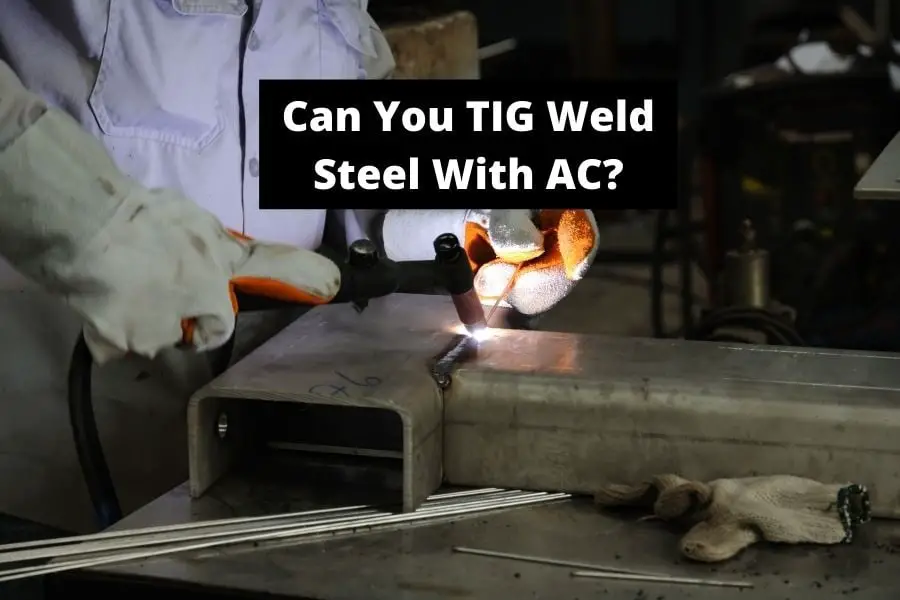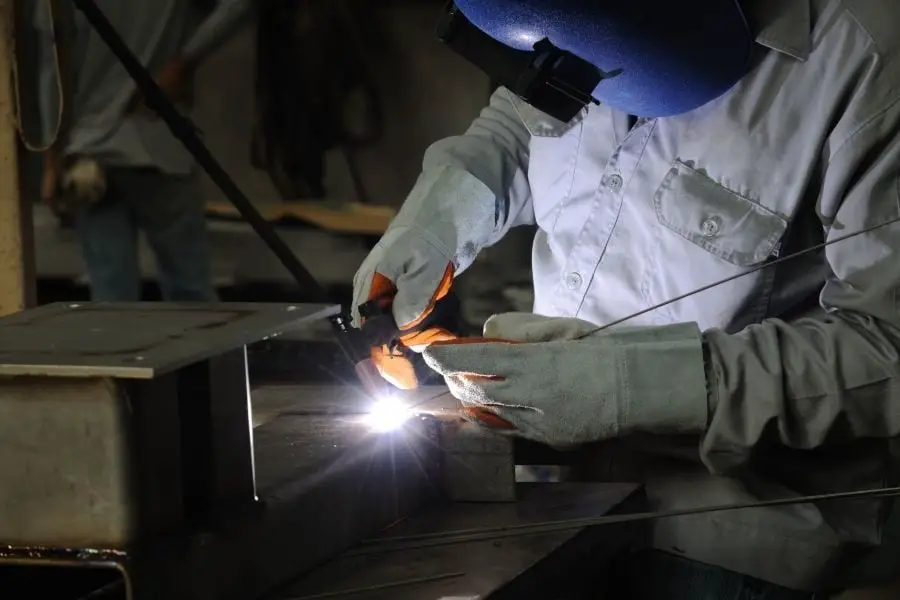
If you are new to TIG welding and want to weld steel, you might have a hard time choosing between AC and DC. It’s pretty common that people weld steel with DC and aluminum with AC. But when you have only AC power available, you might be wondering whether or not can you TIG weld steel with AC.
Yes, you can TIG weld steel with AC. Generally, people do not prefer welding steel with AC but that does not mean that AC cannot be used for steel welding. However, it’s recommended that you use DC welding for steel.
So now another question arises. If you can use AC for welding steel, why do people prefer DC current for that? Actually, there are some benefits of DC current, especially for steel welding. But you can use AC current obviously if you consider some downsides beforehand. Let’s learn about that in detail so that you can make the best decision for TIG welding steel.
Should I Use AC Or DC For Welding Steel?
You can use both AC and DC for TIG welding steel. In general, AC is not a good choice for welding steel. If you are going to buy a new machine for welding steel, consider getting one that is able to use DC. AC is not efficient for welding steel at all.
AC is more preferred for aluminum because aluminum often has film protection that needs to be removed before welding. Steel does not have such a thing, so DC is enough for welding steel. However, steel should be cleaned manually before welding, preferably by using a metal brush or a grinder.
While welding steel using AC, the arc will be a lot unstable and will result in a bad penetration. In the worst case, your tip might get melted. Nevertheless, for welding mild steel, AC should not be the worst choice and you can do it as long as you feel comfortable with it. Remember that quality is the final goal, and you need to assure that no matter what you are using for welding.
The Process of TIG Welding Steel Using AC
If you have no choice but to use AC, you need to keep some things in mind. As AC is not really meant to be worked with steel, you need to follow some precautions. The following steps will help you welding steel using AC easily with almost no downsides.
First of all, you cannot use carbon dioxide for welding steel if you use AC. You must use argon, or else it won’t work. Secondly, you need a big, really big cylinder or argon to use with AC. Argon cylinders go down faster than you imagine, so get enough stock of argon before you start welding.
You can set your flow rate from 15 to 20 CFH, and keep it as low as that. Don’t waste more as argon is already consumed at a higher rate than carbon dioxide. Remember that you need to get a frequency box. The arc of AC on TIG is too unstable for working alone. The high frequency provided by the frequency box will stabilize the arc.
While using AC, the direction of current flow reverses at 60-hertz speed. That causes the arc to ignite in the positive cycle, then extinguish and reignite in the negative cycle. There is a gap between the electrode and base metal while this cycle happens.
Yes, that’s where the high frequency is required. High frequency creates a bridge between this gap in the transition between positive and negative cycles and helps the whole welding process. I will explain this high-frequency model with a bit more information in the next part.

The Difference Between AC and DC in Terms of Welding
If you are curious about the impacts of AC and DC welding and how they differ, I’ve got you covered. In this section I will be talking about just that.
DC Welding
First of all, The DC or direct current makes sure that the current flows in one direction only. Unlike the AC TIG Welding, the current flow does not go to zero until you finish welding. In the current market, most of the TIG inverters are able to do both AC and DC except a few cheap machines.
The direct current – electrode negative (DCEN) can be used for a lot of materials. While using DC, the welding torch is connected to the negative output of the welding inverter. Then the TIG welder returns the positive output in the return cable.
The electrode positive variant of direct current (DCEP) does exactly the opposite. The welding torch receives positive output and returns the negative output in this case. Now the question is, how DC helps in our work?
Some non-ferrous materials, like aluminum, form an oxide on the surface if kept open in the normal atmosphere. The oxide is created by the reaction of oxygen in the air. The problem is, this oxide needs a higher melting point than the base material and needs to be removed before welding.
Though this oxide is hard, you can easily remove it by grinding, brushing, or maybe using some chemical solutions. But it’s efficient to remove it during welding as this forms when you keep the object open in the air.
Direct current helps a lot in this case. The electron flow of DC breaks down and removes the oxide over the aluminum. The DCEN penetrates deeply while DCEP breaks the oxide, combining both results a good quality welding.
The problem is this combination is not easy. DCEP has a high temperature that makes the penetration difficult. Instead of using both DCEP and DCEN, I suggest using AC only.
AC Welding
The alternating current or AC mode is able to do both the positive and negative current supply in one go. In this mode, the welding inverter supplies either positive and negative elements or half-cycles. One positive element and one negative element are combined and called one cycle in AC mode.
In plain English, the current flow of AC goes one way and the other at different times, so it’s named alternating current. The AC mode runs at 50-60 HZ and this high frequency increases magnetic effects. The increased magnetic effect causes transformer efficiency and arc stability. Thus you have better control over your welding process.
AC is better in a lot of ways if you are a regular welder. AC provides maximum penetration using increased heat while maintaining a stable travel speed. To achieve that, you need to place the control to a position that will enable the current to spend more time in the negative half cycle. This will help using higher current with smaller electrodes while the heat will go to the positive cycle, resulting in deeper penetration.
If you want better cleaning, AC can also help you with that. For achieving that, you need to do the opposite as you did for maximum penetration. You must position your control to a place that maximizes the time spent on positive cycles. That will allow active cleaning current and decent penetration.
Conclusion
After reading the whole article, I hope you were able to make the decision about which form of current you need to use for TIG welding steel and whether or not can you TIG weld steel with AC. Sure it is possible but it might create a lot of unnecessary complications which may not make it worth it for some. Thanks for reading and I wish you the best of luck with your project. Until next time, farewell.
